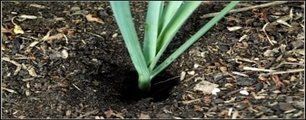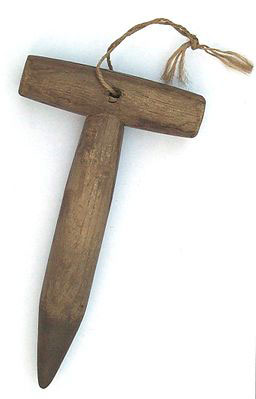Warriston variety of the month
A monthly selection of fruit, veg or flowers that flourish on the Warriston site. Find more in our variety archive
|
A ‘leeklet’ at Warriston Photo:EC
A ‘T-dibber’ for planting leeks
Photo: Simon Speed |
March 2017 - Leeks, ‘Musselburgh’Leeks (Allium porrum) ‘Musselburgh’ as recommended by an east side plot holder.
Leeks are a great vegetable to grow in our climate, especially if you are a beginner and are looking for something easy to grow without the need for lots of ongoing maintaiance. ‘Musselburgh’ is an old Scottish variety which remains popular, is pretty hardy, matures in the autumn but can be left in the cold soil for a long harvest period. Other varieties include ‘Bandit’ which matures late in the winter season and is said to have good resistance to rust and bolting. ‘Pandora’ is productive, quick to mature and is resistant to rust. Site: Ideally leeks prefer a sunny, open site with well fed soil. They are a member of the allium family, so shouldn’t follow other alliums (such as onions and garlic) in a crop rotation system. Sowing: leeks can be sown directly into the soil but tend to do better if started off in indoors. Sow in seed trays in late winter/early spring indoors in a propagator/warm greenhouse or late spring in an unheated greenhouse. Broadcast them onto moist compost and cover with a little more compost. Don’t water them from above after you have sown them as this can wash the little seeds to one side of the tray. It is better to sit the tray in water and let the compost soak it up. Once they are about 15cm tall, when they have a bit of width, pot into modules or 7cm pots. Grow on, then harden them off ready to plant out when the soil is warm enough (around May or early June). If you can be bothered, you can trim the roots a little (to about 2.5cm) which stops them getting tangled up and makes them easier to plant. Planting: outside in rows 30cm apart, at 15cm spacings. Use a dibber (or broken and sharpened wooden spade shaft!) to make a hole about 15cm deep for each ‘leeklet’ (as shown in photograph). Plop the plant in and water it. This ‘puddling in’ will start backfilling the earth: weather and time will complete the process. As the plant grows you can earth up the plants a bit above soil level to increase the blanched stem, which is more tasty and softer than the green parts. General maintenance: keep well watered until established. Feed occasionally if you like and keep weeded. Successional sowing will ensure you get a long harvest period. Apart from that, they are fairly undemanding. Pests and other problems: pigeons and other birds sometimes enjoy pulling up the newly planted leeklets so if this starts to be a problem you can net over or cover with fleece until they are established. Rust can be a problem, especially in hot weather. This appears as areas of orange pustules on the plant. To prevent this you can try and choose resistant varieties, remove and destroy (don’t compost!) affected plants, keep beds weed free and rotate your crops. If they get too dry they can bolt and flower, which makes them inedible, but then offers you the potential for collecting seeds for next year! EC |




